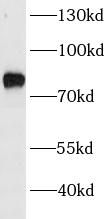Products
CUX1 antibody
| Size | Price |
|---|---|
| 100µg | Inquiry |
- SPECIFICATIONS
- FIGURES
- CONDITIONS
- FAQS
- Product Name
- CUX1 antibody
- Catalogue No.
- FNab02083
- Size
- 100μg
- Form
- liquid
- Purification
- Immunogen affinity purified
- Purity
- ≥95% as determined by SDS-PAGE
- Clonality
- polyclonal
- Isotype
- IgG
- Storage
- PBS with 0.02% sodium azide and 50% glycerol pH 7.3, -20℃ for 12 months(Avoid repeated freeze / thaw cycles.)
- Immunogen
- cut-like homeobox 1
- Alternative Names
- Homeobox protein cut-like 1|CCAAT displacement protein (CDP)|CDP/Cux p200|Homeobox protein cux-1|CDP/Cux p110|CUX1|CUTL1 antibody
- UniProt ID
- P39880
- Observed MW
- 80 kDa
- Tested Applications
- ELISA, WB, IF, IHC, IP
- Recommended dilution
- WB: 1:1000-1:3000; IP:1:500-1:2000; IHC: 1:50-1:200; IF: 1:10-1:100
 Jurkat cells were subjected to SDS PAGE followed by western blot with FNab02083(CUX1 antibody) at dilution of 1:1000
Jurkat cells were subjected to SDS PAGE followed by western blot with FNab02083(CUX1 antibody) at dilution of 1:1000
 IP Result of anti-CUX1 (IP:FNab02083, 4ug; Detection:FNab02083 1:1000) with mouse brain tissue lysate 4000ug.
IP Result of anti-CUX1 (IP:FNab02083, 4ug; Detection:FNab02083 1:1000) with mouse brain tissue lysate 4000ug.
 Immunohistochemistry of paraffin-embedded mouse brain using FNab02083(CUX1 antibody) at dilution of 1:100
Immunohistochemistry of paraffin-embedded mouse brain using FNab02083(CUX1 antibody) at dilution of 1:100
 Immunofluorescent analysis of HepG2 cells, using FNab02083(CUX1 antibody) at 1:25 dilution and Rhodamine-labeled goat anti-rabbit IgG (red).
Immunofluorescent analysis of HepG2 cells, using FNab02083(CUX1 antibody) at 1:25 dilution and Rhodamine-labeled goat anti-rabbit IgG (red).
- Background
- Probably has a broad role in mammalian development as a repressor of developmentally regulated gene expression. May act by preventing binding of positively-activing CCAAT factors to promoters. Component of nf-munr repressor; binds to the matrix attachment regions(MARs)(5' and 3') of the immunoglobulin heavy chain enhancer. Represses T-cell receptor(TCR) beta enhancer function by binding to MARbeta, an ATC-rich DNA sequence located upstream of the TCR beta enhancer. Binds to the TH enhancer; may require the basic helix-loop-helix protein TCF4 as a coactivator(By similarity).
How many times can antibodies be recycled?
First, usually it's not suggested to recycle antibodies. After use, buffer system of antibodies has changed. The storage condition of recycled antibodies for different customers also varies. Thus, the performance efficiency of recycled antibodies can’t be guaranteed. Besides, FineTest ever conducted the antibody recycling assay. Assay results show recycling times of different antibodies also varies. Usually, higher antibody titer allows more repeated use. Customers can determine based on experimental requirements.
Notes: After incubation, we recycle rest antibodies to centrifuge tube and store at 4℃. High titer antibodies can be stored for a minimum of one week. Reuse about three times.
What are components of FineTest antibody buffer?
Components of FineTest antibody buffer are usually PBS with proclin300 or sodium azide, BSA, 50% glycerol. Common preservative is proclin300 or sodium azide, which is widely applied in the lab and industry.
How about the storage temperature and duration of FineTest antibodies?
Most antibodies are stored at -20℃. Directly-labeled flow cytometry antibodies should be stored at 2 - 8℃. The shelf life is one year. If after sales issues for purchased antibodies appear, return or replacement is available. Usually, antibodies can be still used after the one-year warranty. We can offer technical support services.
Is dilution required for FineTest antibodies? What’s the dilute solution?
Directly-labeled flow cytometry antibodies are ready-to-use without dilution. Other antibodies are usually concentrated. Follow the dilution ratio suggested in the manual. Dilute solution for different experiments also varies. Common antibody dilution buffers are acceptable(e.g. PBST, TBST, antibody blocking buffer).
How to retrieve antibodies for immunohistochemistry?
Common retrieval buffers: Tris-EDTA Buffer(pH 9.0); Citrate Buffer(pH 6.0)
Heat induced antibody retrieval:
Method 1: Water-bath heating: Put the beaker with retrieval buffer and slide in the boiling water bath. Keep the boiling state for 15min. Naturally cool to room temperature;
Method 2: Microwave retrieval: Put the beaker with retrieval buffer and slide in the microwave oven. Heat at high power for 5min, Switch OFF for 3min, Heat at medium power for 5min. Naturally cool to room temperature.
How to choose secondary antibodies?
(1) Secondary antibodies react with primary antibodies. Thus, secondary antibodies should be against host species of primary antibodies. E.g. If the primary antibody is derived from rabbit, the relevant secondary antibody should be against rabbit. E.g. goat anti rabbit or donkey anti rabbit.
(2) Choose secondary antibody conjugates according to the experimental type, e.g. ELISA, WB, IHC etc. Common enzyme conjugated secondary antibodies are labelled by HRP, AP etc. Fluorescin or dye labelled secondary antibodies are applied in immunofluorescence and flow cytometry(e.g. FITC, Cy3).
